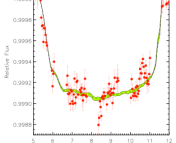- Title: Hot Jupiter radius anomalies explained
- Author: Konstantin Batygin, David J. Stevenson & Peter H. Bodenheimer
- Institution: California Institute of Technology & UC Santa Cruz, CA
Introduction
Dozens of the transiting exoplanets discovered to date have radii that are significantly larger than expected, leading astronomers to refer to them as puffy or inflated. The sizes of many of these planets cannot be explained by making them out of lighter elements (requiring a larger size for a given mass), giving them higher temperatures (gases expand when heated) or making them younger (younger planets tend to be larger). For the most part, explanations of how these planets got to be so big has centered on the effect of tides. The idea is that as a result of having an eccentric orbit, the planet is subject to tides which heat up its interior. When you heat up a gas, it will expand. Tidal heating can explain some, but not all, of the inflated radii observed. (For an example, see a paper by Ibgui, Burrows and Spiegel, which applies the tidal heating scenario to several planets. The introduction also gives a good background.)
Although tidal heating has had some success modeling puffy planets, other means for inflating planets have been explored. In this paper, the authors continue work on a new mechanism which employs planetary magnetic fields. Hot Jupiters are strongly heated by their host star, leading to fast, hot winds. The temperature is high enough that some elements (alkali metals) become partially ionized, resulting in a supply of free electrons. The interaction of this weakly ionized wind with the planet’s magnetic field drives current loops through the planet. Passing a current through a material results in Ohmic (or Joule) heating, which converts electric energy to thermal energy (think of touching your computer power source…).
Methods
Their planet models include convective and radiative zones and a constant density core. Many parameters are based on work done in detail by other authors. In addition to Ohmic heating, they include gravitational contracting and the cooling of the interior as additional energy sources. They also include limits on the efficiency of Ohmic heating which are the result of the winds slowing down. High ionization levels and strong magnetic fields can damp the wind velocity.
Batygin & Stevenson had previously applied this mechanism to two puffy planets and were able to explain their radii (one, however, required a higher metallicity than is usually considered). In this work, the authors look at the radial evolution of many model planets. The model planets have masses between 0.23 and 3 Jupiter masses and effective temperatures between 1000 and 1800K. Except in one case, the models do not include a core.
Results

Figure 1: Models including Ohmic heating; if correct all observed planets should lie below the models, at smaller radii.
The authors plot radius v. temperature for planets of varying masses. Then, they overplot observed planets. Because their model planets are core-less, the radii they determine are an upper bound (adding a core would decrease the radius required to fit a planet of a given mass). For their hypothesis to be correct, all observed planets (and all planets to be observed in the future) should lie below the model curve corresponding to a planet of that mass. For example, all exoplanets should lie below the
model curve–that is, should have smaller radii than that model. From Figure 1, we can see that this is the case.
Although Ohmic dissipation can explain the observed radii of Hot Jupiters, there are some problems. First, some solutions are unstable and end up in a runaway growth phase (see Figure 2); these planets will end up overflowing their Roche lobe and evaporating (the Roche lobe of a planet defines a region beyond which material is attracted to the host star instead of the planet; if a planet expands beyond its Roche lobe, it loses mass to the star). Higher mass planets are stable for longer, and one can keep lower mass planets from evaporating by giving them very massive, metal-rich cores. However, it is possible that evaporation could explain some observations of solitary sub-giant planets: perhaps they began life as a giant planets, which then lost mass through evaporation. If this hypothesis is true, planets in the evaporation stage should eventually be observed.
Low mass planets pose an additional problem, because the model radii are so much larger than observed radii. In order to fit the data, one either needs massive cores or a way to make Ohmic heating less efficient (other than the ways described in the Methods section). However, these are reasonable requirements.






Trackbacks/Pingbacks